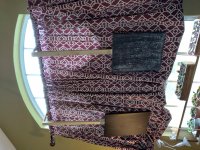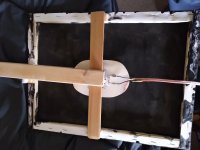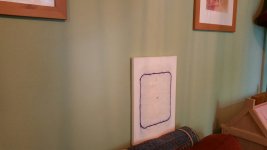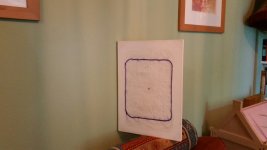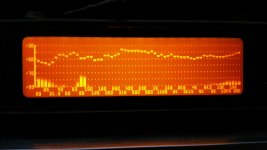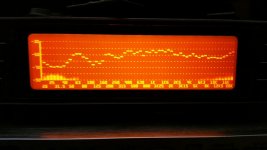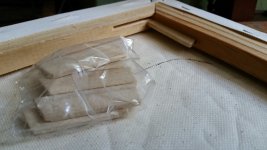Carlos.
If you place the panels up against the wall you will loose frequencies below about 200hz .
I showed this in the videos I made, and talked about ways to get around this problem.
If heavy film soundtrack sub bass is needed,then I would suggest a proper subwoofer.
Alternatively a bass shaker attached to the frame of the bed should do the trick 😀
The first exciter on your list should work well with the ply canvas panel.
The second one is a bass shaker and I think it says it only goes up to 150hz ?
I'd personally would try the panel first and see if it does the job needed ,if more LF IS needed then find other methods.
There are many different types of dml panels and all should do well for surround speakers with appropriate xo.
Steve .
If you place the panels up against the wall you will loose frequencies below about 200hz .
I showed this in the videos I made, and talked about ways to get around this problem.
If heavy film soundtrack sub bass is needed,then I would suggest a proper subwoofer.
Alternatively a bass shaker attached to the frame of the bed should do the trick 😀
The first exciter on your list should work well with the ply canvas panel.
The second one is a bass shaker and I think it says it only goes up to 150hz ?
I'd personally would try the panel first and see if it does the job needed ,if more LF IS needed then find other methods.
There are many different types of dml panels and all should do well for surround speakers with appropriate xo.
Steve .
Yes, of course my first idea was to put a proper sub, probably a band-pass box with 6.5" driver I have, under the bed, with it's own Bluetooth amp, filtered below 250Hz at theamp output. Being BT it will be difficult to filter inside the amp.
The ideal thing would be using a BT preamp, which I don't know if it exists, and add an active prametric filter at the output, before the power amp.
I am not considering putting the panels farther than 2" from the wall, neither those on the bedroom or the surround ones. How low do they get at that distance? Are there curves showing that response?
The ideal thing would be using a BT preamp, which I don't know if it exists, and add an active prametric filter at the output, before the power amp.
I am not considering putting the panels farther than 2" from the wall, neither those on the bedroom or the surround ones. How low do they get at that distance? Are there curves showing that response?
Carlos.
To me it would seem pointless building a quality full range panel speaker and then bolting it to a wall.
This would strangle the low end to about three of four hundred hz and also greatly interfere with the sound above this.
Personally I'd probably use one of my small card or thin ply panels which , if I remember correctly don't have such a problem with wall boundaries .
But you would still need an ordinary bass mid driver to cover the small panel cut off point.
I could measure my not so small veneer panel and see how it sounds against the wall, I could even record it ,that is if you are able to download the mp4 from this site?
Sorry for the negativity about the canvas wall mounting , but there are other options.
Steve
To me it would seem pointless building a quality full range panel speaker and then bolting it to a wall.
This would strangle the low end to about three of four hundred hz and also greatly interfere with the sound above this.
Personally I'd probably use one of my small card or thin ply panels which , if I remember correctly don't have such a problem with wall boundaries .
But you would still need an ordinary bass mid driver to cover the small panel cut off point.
I could measure my not so small veneer panel and see how it sounds against the wall, I could even record it ,that is if you are able to download the mp4 from this site?
Sorry for the negativity about the canvas wall mounting , but there are other options.
Steve
No, it's OK. I have to face reality. Better to know now and not later, when things were already assembled.
The question is I need a flat system to improve the audio of my bedroom TV. Flat in spectrum as in shape. The Philips speakers I use now are full range, used in in an unknown audio system I just use the speakers of.
It has one 5" full range, with a tube going up front to increase the bass.
What I described before, using an under the bed band pass regular sub, with a separate amp, BT linked, might be the only option for me.
I can't advance from the wall too much with the planes, because they would be in the people's path.
My options to improve this are limited.
The question is I need a flat system to improve the audio of my bedroom TV. Flat in spectrum as in shape. The Philips speakers I use now are full range, used in in an unknown audio system I just use the speakers of.
It has one 5" full range, with a tube going up front to increase the bass.
What I described before, using an under the bed band pass regular sub, with a separate amp, BT linked, might be the only option for me.
I can't advance from the wall too much with the planes, because they would be in the people's path.
My options to improve this are limited.
This is they guy I several video about panel speakers.
World’s Best Speakers! - YouTube
Hay you seen them?
World’s Best Speakers! - YouTube
Hay you seen them?
Carlos .
So a smaller panel attached to the ceiling or hinged out from the side wall is a no go too ?
I did place my rigid ply panels on the wall at one stage but can't remember the outcome?
You obviously loose the rear wave unless you maybe use 2inch foam on the sides instead of wood ?
Foam damping might help prevent some of the worst sounds from the close reflective surfaces, but not sure of how this would effect the LF ?
It's not easy to recommend things without knowing the room layout and acceptable panel sizes.
Steve.
So a smaller panel attached to the ceiling or hinged out from the side wall is a no go too ?
I did place my rigid ply panels on the wall at one stage but can't remember the outcome?
You obviously loose the rear wave unless you maybe use 2inch foam on the sides instead of wood ?
Foam damping might help prevent some of the worst sounds from the close reflective surfaces, but not sure of how this would effect the LF ?
It's not easy to recommend things without knowing the room layout and acceptable panel sizes.
Steve.
Carlmart,
If you are going to have your DMLs at the wall, you need a damping surface behind them. I have my DMLs in front of my window drapes, suspended from L-frames sitting on the desk in front of the window. I used 1/2" melamine sponges I glued together to make a 15x12" panel to go inside the drapes to further add to the damping. The total distance from the window panes to the front of the DMLs is about a foot, and I have good response down to at least 40Hz. Some variation of this setup might work for you. Alternatively, you could come off the wall either side of the TV, and this might not be too intrusive into the room. Just be sure the DMLs are not touching anything that could vibrate (such as the wires) or restrict their slight movement. I wouldn't think touching the drapes would have much effect on their sound quality.
If you are going to have your DMLs at the wall, you need a damping surface behind them. I have my DMLs in front of my window drapes, suspended from L-frames sitting on the desk in front of the window. I used 1/2" melamine sponges I glued together to make a 15x12" panel to go inside the drapes to further add to the damping. The total distance from the window panes to the front of the DMLs is about a foot, and I have good response down to at least 40Hz. Some variation of this setup might work for you. Alternatively, you could come off the wall either side of the TV, and this might not be too intrusive into the room. Just be sure the DMLs are not touching anything that could vibrate (such as the wires) or restrict their slight movement. I wouldn't think touching the drapes would have much effect on their sound quality.
Last edited:
carlmart,
My panels are 12x16". I am in the process of turning the L-frames upside down and setting them on the desk in front of the window. The ply pieces on which the exciters are mounted are 4x6", and are pieces of wall paneling from which I shaved one of the plies to make them thinner. They are about 3-4mm thick. I used acrylic paint thinned 50% with water to paint them, as I didn't like the look of the white canvas. One panel is black and the other a mottled grey. I will try to make a recording from them soon, but I haven't had much luck getting any volume to speak of when I've tried to use my phone to record. They can easily play 40 Hz.
My panels are 12x16". I am in the process of turning the L-frames upside down and setting them on the desk in front of the window. The ply pieces on which the exciters are mounted are 4x6", and are pieces of wall paneling from which I shaved one of the plies to make them thinner. They are about 3-4mm thick. I used acrylic paint thinned 50% with water to paint them, as I didn't like the look of the white canvas. One panel is black and the other a mottled grey. I will try to make a recording from them soon, but I haven't had much luck getting any volume to speak of when I've tried to use my phone to record. They can easily play 40 Hz.
Attachments
Last edited:
Yarap.
The panels look and sound like they are made by a company called wavesound , I think ?
Steve.
The panels look and sound like they are made by a company called wavesound , I think ?
Steve.
So this is a very nice vid of a guy that has built the standard 2'x2' XPS panels. The listening test is quite interesting as he tests the panels in many configurations and compares them with a set of Klipsch R-41M Bookshelf Speakers: Testing Viewer Suggestions on “The World's Best Speakers” from Tech Ingredients - YouTube
He built the panels with these differences:
Original flat panel design
Originals with Subwoofer
Originals with 2 Exciters
Originals with 2 Exciters and Sub
Painted
Light Weight Fabric.
Medium Weight Fabric
Square
Square No Sanding
Triangular
Fixed Exciter
And directly compares them all with all levels matched using the following music types:
Indie Pop
Swing Jazz
Modern Blues
Hard Rock/Metal
Classical Guitar
Modern Country
Electronica/Dubstep
Hip Hop
Pop Rock
Classical Strings
He built the panels with these differences:
Original flat panel design
Originals with Subwoofer
Originals with 2 Exciters
Originals with 2 Exciters and Sub
Painted
Light Weight Fabric.
Medium Weight Fabric
Square
Square No Sanding
Triangular
Fixed Exciter
And directly compares them all with all levels matched using the following music types:
Indie Pop
Swing Jazz
Modern Blues
Hard Rock/Metal
Classical Guitar
Modern Country
Electronica/Dubstep
Hip Hop
Pop Rock
Classical Strings
Geosand.
He has put a lot of work into that demonstration video very interesting.
He and practically everyone else has misunderstood the original point of sanding the panel mainly because of tech ingredients.
They (if I remember correctly ) thought it made a good room sound deadening panel as well as a dml ?
Here's some pictures .
The first is the art panel now with a coat of 50x50 pva on the front, not much change, I hoped it would shink a little more.
The second is the same panel with some wood pushed under the fame to tighten it up a bit.
The response in the 25hz has moved up to 40hz, and filled in the dips up to 125hz , this was at 12inches of course .
Still very weak below 125 hz.
The third picture is of the 6x9 inch veneer panel, very similar to the art panel..
Both OK above 125hz but the in room response of the veneer panel drops a little more so would xo about 150 to 160 .
Steve.
He has put a lot of work into that demonstration video very interesting.
He and practically everyone else has misunderstood the original point of sanding the panel mainly because of tech ingredients.
They (if I remember correctly ) thought it made a good room sound deadening panel as well as a dml ?
Here's some pictures .
The first is the art panel now with a coat of 50x50 pva on the front, not much change, I hoped it would shink a little more.
The second is the same panel with some wood pushed under the fame to tighten it up a bit.
The response in the 25hz has moved up to 40hz, and filled in the dips up to 125hz , this was at 12inches of course .
Still very weak below 125 hz.
The third picture is of the 6x9 inch veneer panel, very similar to the art panel..
Both OK above 125hz but the in room response of the veneer panel drops a little more so would xo about 150 to 160 .
Steve.
Attachments
Steve,
I started out in life as an artist/painter.
I learned that one can very easily tighten a canvas by spaying or sponging warm or hot water on the back of the canvas - even a canvas with the front already sized with rabbit skin glue or primed with acrylic or PVA.
Restorers will even do this with old paintings.
That said, one can also get stretcher bars that come with a pair of small wooden keys (triangular wedges) in each corner. One can tap the keys to spread the stretcher bars and tighten the canvas.
Andreas
I started out in life as an artist/painter.
I learned that one can very easily tighten a canvas by spaying or sponging warm or hot water on the back of the canvas - even a canvas with the front already sized with rabbit skin glue or primed with acrylic or PVA.
Restorers will even do this with old paintings.
That said, one can also get stretcher bars that come with a pair of small wooden keys (triangular wedges) in each corner. One can tap the keys to spread the stretcher bars and tighten the canvas.
Andreas
- Home
- Loudspeakers
- Full Range
- A Study of DMLs as a Full Range Speaker
